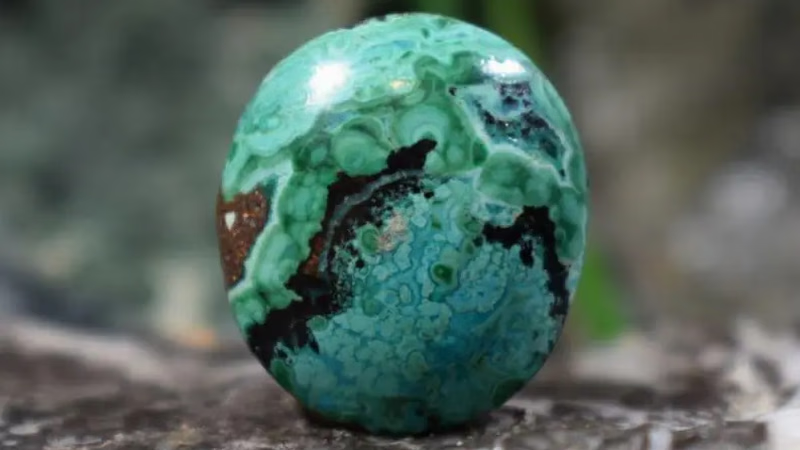
Chrysocolla exhibits vibrant colors similar to turquoise.
Chrysocolla and turquoise may share some similarities, particularly in their vibrant blue to green colors, but they are distinct minerals with different properties and compositions. Both stones are popular in jewelry and ornamental carvings due to their attractive colors, and they are associated with copper deposits and often found in similar geological environments. Metaphysically, they are believed to have calming and balancing properties and are used in crystal healing, often associated with communication and emotional well-being. However, there are notable differences between chrysocolla and turquoise. In terms of composition, chrysocolla is a hydrated copper phyllosilicate mineral, while turquoise is a hydrated phosphate of copper and aluminum. Chrysocolla is softer, with a Mohs hardness of 2.5 to 3.5, while turquoise is harder, with a Mohs hardness of 5 to 6. Their luster also differs, with chrysocolla typically having a vitreous to dull luster and turquoise usually exhibiting a waxy to subvitreous luster.
The structure of the two minerals is distinct as well. Chrysocolla is often found in botryoidal or massive forms and can be mixed with other minerals like quartz. On the other hand, turquoise is usually found in nodules or as veins within host rock, and it often displays a more uniform structure with distinctive veining, known as matrix. Their specific gravities also differ, with chrysocolla having a specific gravity of approximately 2.0 to 2.4, while turquoise has a higher specific gravity, typically around 2.6 to 2.9. Chrysocolla with light blue and turquoise green is very attractive and is the most famous type of Chrysocolla. Its color is due to the presence of copper impurities. Although chrysocula may be a lesser-known gemstone, it is still a fascinating gem that many gem and mineral enthusiasts are looking for. The name chrysocolla is derived from the two Greek words "chrysos" and "kolla", which mean "gold" and "glue", respectively. The reason for this naming is that it is usually used as an agent in gold soldering but ultimately, the term has become a general reference for any green copper mineral.
Chrysocolla is formed in areas containing oxidation of copper deposits and is considered as a small rock of mineral copper. Pure chrysocolla gemstones are rare. Chrysocolla is often formed with other copper minerals, leading to gemstones with interesting and unique compositions and spotted colors and patterns. Some common mineral compounds are azurite (which Chrysocula often resembles), malachite and turquoise. Chrysocolla may also be composed of light crystalline layers of glossy and polished quartz.Which basically creates a natural double stone (a stone made by joining two stones together). In many cases, quartz crystals may not just remain as crystalline layers and grow along with the rock. Quartz-hybrid compounds are harder and more durable than pure Chrysocolla, which often makes them suitable for use in jewelry.
Stability is another differentiating factor. Chrysocolla is more sensitive to heat and chemicals, which can cause it to crack or discolor. Turquoise, although generally more stable, can still be affected by prolonged exposure to heat, chemicals, or direct sunlight.To differentiate between chrysocolla and turquoise, several identification tips can be helpful. Performing a hardness test can distinguish between the two, considering chrysocolla's softer nature. Visual inspection of the luster and uniformity can also provide clues, as turquoise often exhibits a more waxy luster and uniform color compared to chrysocolla's vitreous to dull luster and mottled appearance. For definitive identification, consulting a gemologist who can conduct advanced testing like spectroscopy or X-ray diffraction is recommended.
-
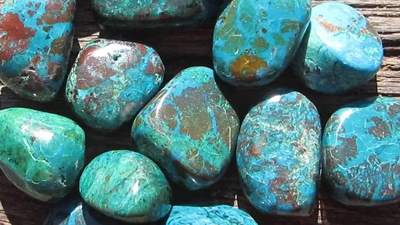
Chrysocolla is a captivating gemstone known for its vibrant blue and green hues, classified as a hydrated copper phyllosilicate mineral. It typically forms in the oxidation zones of copper deposits, with notable sources including Arizona, New Mexico, Chile, Peru, and Israel. The gemstone exhibits a hardness of 2. 5 to 3. 5 on the Mohs scale, making it relatively soft and requiring careful handling. Its luster ranges from vitreous to dull, and it can be opaque to translucent. Chrysocolla is often used in jewelry as cabochons or beads due to its attractive colors and is also valued for its metaphysical properties, believed to enhance communication and self-expression. Additionally, it has applications in decorative objects and carvings.
Despite being lesser-known, Chrysocolla"s unique characteristics make it sought after by gem enthusiasts. The name derives from Greek words meaning "gold" and "glue
-
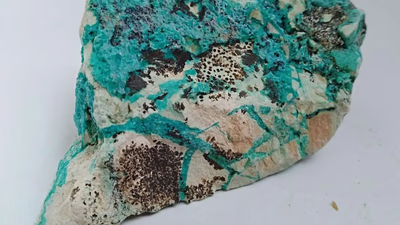
Inspecting rough chrysocolla is essential for determining cutting methods. The stone should be examined for cracks and weak spots before marking it for cutting. A trim saw with a diamond blade is used to cut the stone into slabs, ensuring a constant water flow to cool the blade and minimize dust. Safety precautions, including goggles and gloves, are necessary during this process. Shaping involves using a lapidary grinder with coarse grit wheels, followed by finer grits for smoothing. Polishing enhances the stone"s luster using a polishing wheel and compounds like cerium oxide. Chrysocolla can be fashioned into cabochons for jewelry, particularly pendants and earrings, due to its softness and sensitivity to water. Careful maintenance is crucial; avoid prolonged exposure to water, direct sunlight, and harsh chemicals.
When cleaning, use a soft cloth with mild soap. Store chrysocolla separately from other gemstones to prevent scratches. Artisans may apply protective coatings to enhance durability. Common shapes include ovals and free-cuts, while calibrated sizes are preferred for specific applications. "
-
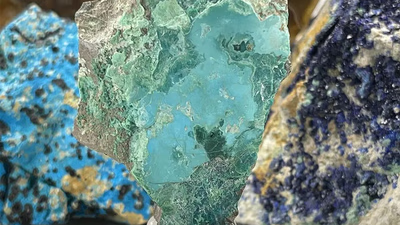
Chrysocolla is identified through visual inspection and physical property testing. Its color ranges from blue to green, often displaying mottled patterns. The hardness of chrysocolla is between 2. 5 and 3. 5 on the Mohs scale, making it softer than turquoise. Specific gravity tests reveal values between 2. 0 and 2. 4, while the streak test shows a white to light blue-green powder.
Due to its variable chemical composition, chrysocolla can be confused with similar minerals like turquoise and azurite. Notable sources include Arizona, Israel, and the Democratic Republic of Congo, with advanced techniques like spectroscopic analysis and X-ray diffraction aiding in identification. For accurate results, consulting a professional gemologist is recommended, especially when purchasing valuable pieces. Buyers should seek certification from reputable laboratories and buy from trusted dealers to ensure authenticity.
-

Chrysocolla and turquoise, while both featuring vibrant blue to green hues, are distinct minerals with unique properties. Chrysocolla is a hydrated copper phyllosilicate, softer than turquoise, which is a hydrated phosphate of copper and aluminum. The hardness of chrysocolla ranges from 2. 5 to 3. 5 on the Mohs scale, whereas turquoise measures between 5 and 6. Their luster also varies; chrysocolla typically has a vitreous to dull finish, while turquoise displays a waxy to subvitreous sheen. Geologically, both stones are associated with copper deposits but differ in structure: chrysocolla often appears botryoidal or massive, while turquoise is found in nodules or veins within host rock. Specific gravity further distinguishes them—chrysocolla"s ranges from 2.
0 to 2. 4 compared to turquoise"s 2. 6 to 2. 9. Chrysocolla"s attractive light blue and turquoise green colors stem from copper impurities, making it sought after by gem enthusiasts despite being lesser-known than turquoise. The name "chrysocolla" derives from Greek words meaning "gold" and "glue
-
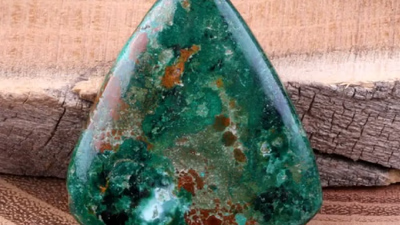
Chrysocolla is a unique gemstone characterized by its vibrant blue to green hues, often found in massive or botryoidal forms. Its appearance can vary significantly based on its mineral associations, such as when combined with quartz, resulting in varieties like Chrysocolla Chalcedony. Other notable combinations include Eilat Stone and Sonora Sunrise, which showcase striking color patterns. Identifying chrysocolla involves examining its color distribution, hardness (2. 5-3. 5 on the Mohs scale), specific gravity (2. 0-2. 4), and luster.
While pure chrysocolla is rare, it is often sold mixed with other minerals under the same name. Similar gemstones include turquoise, malachite, azurite, and variscite, each differing in hardness and appearance. Pricing for chrysocolla jewelry depends on factors such as weight, color purity, cutting quality, and transparency levels ranging from D (clearest) to M (most opaque). Understanding these characteristics is essential for both buyers and sellers in the gemstone market.





